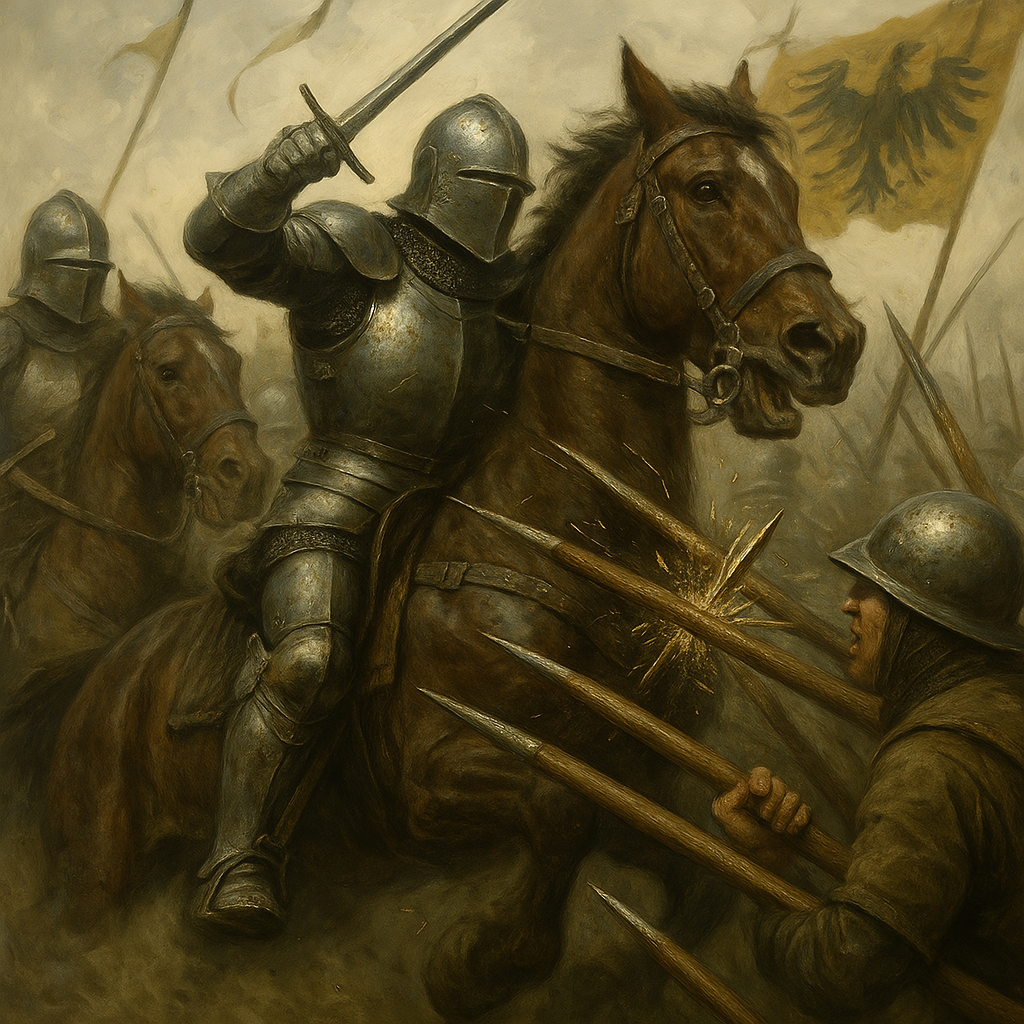July 9, 1386 marked more than a clash of steel— it unleashed a collective spirit that carved Swiss independence and inspired generations. Amid rolling hills and serene meadows, a small confederation of mountain farmers and tradesmen defied the mighty Habsburg dynasty. Their daring defense and legendary selflessness echo across centuries, offering modern individuals timeless lessons in unity, leadership, and resilience.
In this blog we journey back to that mist-shrouded battlefield, unpack the strategies and sacrifices that decided the fate of medieval Europe, and distill actionable insights you can apply today. Whether you lead a team at work, rally community efforts, or seek to galvanize personal projects, the Battle of Sempach holds keys to forging solidarity and driving transformative results. Let’s march forward together into a saga of valor, strategy, and enduring inspiration.
Setting the Stage: Europe in the 14th Century
The mid-1300s in Europe were defined by shifting allegiances, fractured realms, and the aftershocks of the Black Death. Feudal lords vied for land, while burgeoning cities and guilds nurtured the dawn of mercantile power. Across this volatile landscape, the Old Swiss Confederacy began as a defensive pact among three alpine cantons—Uri, Schwyz, and Unterwalden—intent on safeguarding critical mountain passes.
Established by the legendary Federal Charter of 1291, this loose alliance reflected a thirst for local self-governance, communal justice, and shared defense. Villages pledged mutual aid against brigands, tax collectors, and overreaching nobles. As merchants traversed transalpine routes with precious cargo, the cantons realized that unity offered protection and prosperity far surpassing isolated autonomy.
By the 1380s, the Confederacy had repelled earlier incursions and honed unconventional infantry tactics. Lightly armored foot soldiers wielding long pikes and halberds began challenging the dominance of heavy cavalry. Habsburg interests, however, eyed the Swiss plateau as vital for their trade networks and political leverage. Duke Leopold III prepared a formidable force to force fealty and extract tribute. When their horses faltered against pike formations and rough terrain, Habsburg knights would discover that medieval warfare was evolving beyond chivalric charges.
Road to Sempach
In early summer 1386, reports swirled that Duke Leopold’s army—some 5,000 mounted knights, crossbowmen, and foot soldiers—would descend upon Sempach, aiming to split the Confederacy’s defenses. Alarmed by the looming threat, representatives from eight cantons convened in Lucerne. Though seldom unanimous, they faced a stark choice: capitulate or unite.
Drawing on centuries-old pacts, Swiss leaders mustered approximately 1,500 men—farmers trading scythes for halberds, blacksmiths reinforcing scrap metal into breastplates, and townsmen sharpening long pikes. Villages emptied as harvests waited, and communal workshops buzzed with activity through moonlit nights. When kin and neighbors toiled side by side, a fierce solidarity ignited that transcended individual cantonal loyalties.
Logistics challenged the Swiss—limited provisions, no cavalry, and uneven armor—but morale soared. Fresh from defensive successes at Morgarten and more recent skirmishes, they believed disciplined pike squares could withstand even the most devastating cavalry onslaught. With banners of red and white unfurled, the Confederacy’s motley host prepared to meet Habsburg steel on their own soil.
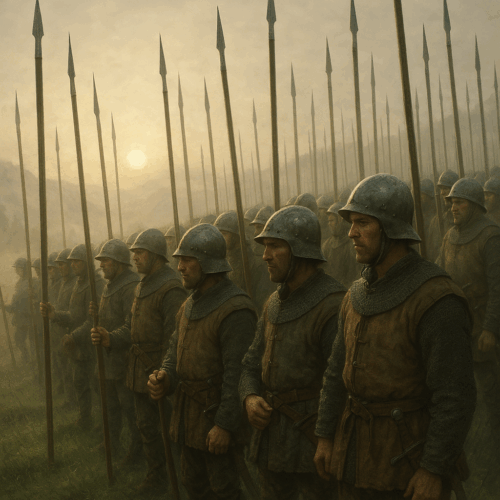 The Armies Assemble
The Armies Assemble
On July 8, the Swiss and Austrian forces faced off across gentle slopes south of Lake Sempach. Leopold’s formation followed classical medieval design: knights in full plate armor massed at the center, flanked by crossbowmen and spearmen, banners bearing the Imperial eagle rippling in the breeze. Gleaming lances pointed skyward, concealing the deadly intent to crush the Confederates in a single, decisive charge.
Opposing them, the Swiss adopted a bristling line of halberds and long pikes, each weapon measuring up to 18 feet. Without cavalry, they forwent horses for disciplined infantry wedges. Men in simple mail shirts and leather jerkins braced their wooden pike shafts into the turf, anchoring their stance. A handful of crossbowmen and early handgunners positioned themselves behind cover, ready to fragment the enemy’s cohesion before the famed cavalry charge could form.
From dawn until midday, both camps probed for weakness. Habsburg heralds taunted the Confederates, certain they would waver. Yet the Swiss tighten their ranks like steel itself, humming battle prayers and synchronizing drill commands honed over decades of alpine defense. They waited patiently, trusting that terrain, discipline, and shared purpose would blunt the aristocratic assault.
The Battle Unfolds
At noon on July 9, Duke Leopold signaled the advance. A thunderous roar split the air as heavy cavalry plunged headlong into a forest of pike points. Horses balked at deadly barriers, chests impaled on iron heads. When mounted knights hammered shields and mail, the infantry restrengthened their wedge formation, driving spears into armor joints and sending shockwaves through the enemy flank.
Around the pike phalanx, crossbow bolts whistled and hand-forged arquebus fire cracked, targeting Habsburg officers. Austrian squadrons attempted to wheel around marshy ground, only to find hoofs sinking and banners tumbling. Swiss pikemen pressed forward, their unified push driving knights and footmen into disarray. Screams of valor melded with the crunch of bones and the clang of shattered steel.
Despite numerical inferiority, the Confederates refused to yield. When Austrian reserves formed for a counter-punch, Swiss reinforcements from neighboring ridges poured onto the field. Their combined surge—brief, relentless, and unyielding—routed the remaining cavalry. The battlefield fell silent save for the heavy breathing of survivors and the distant tolling of Lucerne’s bell, ringing news of a stunning underdog victory. [8]
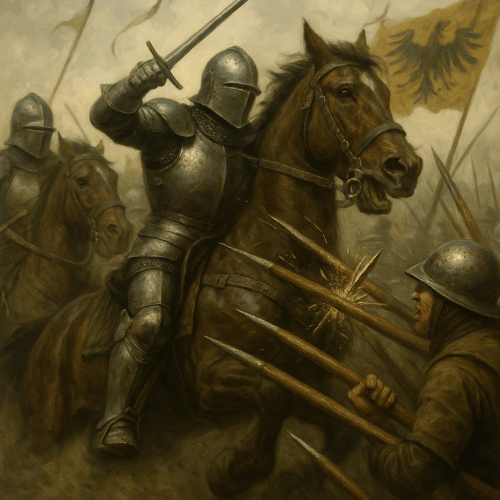 Arnold von Winkelried and the Swiss Resolution
Arnold von Winkelried and the Swiss Resolution
Amid the chaos, legend credits a Swiss foot soldier—Arnold von Winkelried—with performing a sacrificial act that broke the enemy’s back. As knights pressed upon the pike wall, he is said to have cried out for comrades to pierce him with a handful of spears. Clutching as many shafts as he could, he charged the Austrian front, ripping open a corridor in the battle line.
Through that breach, Swiss infantry flooded into the heart of the Habsburg formation. Knights tumbled from their mounts, banners fell, and panic spread. Though historians debate the literal truth of Winkelried’s deed, his symbolic sacrifice galvanized the Swiss resolve and became central to their national ethos. Poets commemorated him in epic ballads, and later generations erected statues honoring his selfless courage.
Beyond myth, Sempach demonstrated the potency of coordinated sacrifice and tactical innovation. It shattered the aura of knightly invincibility and heralded the infantry revolution that would dominate European warfare for centuries to come. [8]
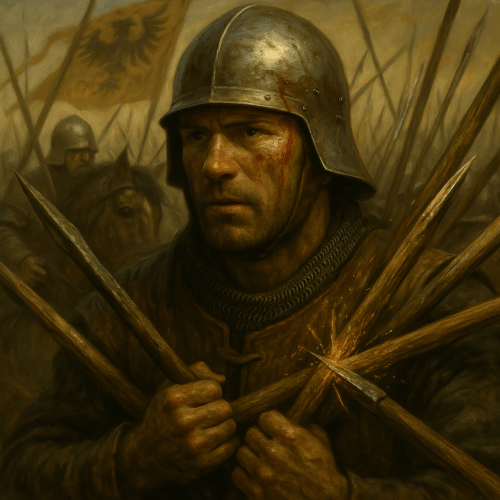 Aftermath and Historical Impact
Aftermath and Historical Impact
The victory at Sempach forced the Habsburgs back, ending their immediate designs on Swiss autonomy. In the months that followed, cantons formerly hesitant to join the Confederacy—such as Lucerne, Zurich, and Zug—ratified defensive treaties. By mid-1388, the Swiss Union counted eight cantons, united in a compact to resist any future overreach.
European powers took note: infantry formations wielding long pikes could thwart the most heavily armored cavalry. The Burgundians, French, and later even the English integrated pike squares and diverse volley fire tactics into their armies. The Swiss themselves, leveraging Sempach’s prestige, evolved a militia system where citizen-soldiers rotated service, creating a reservoir of trained defenders without a standing army.
Culturally, the battle fed the cradle of Swiss identity. Artisans engraved Sempach scenes on stained glass windows; minstrels recited its exploits at town gatherings; councils invoked its lessons when negotiating treaties. The notion that small, free communities could defend themselves against dynastic juggernauts seeped into Swiss political thought, laying groundwork for the republic and enduring neutrality that define modern Switzerland.
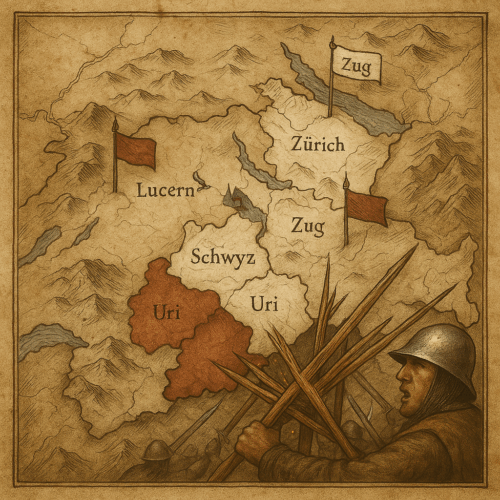 Cultural Reverberations Through the Centuries
Cultural Reverberations Through the Centuries
Long after the swords were sheathed, the spirit of Sempach resonated in European art and literature. Renaissance chroniclers cast the Swiss as paragons of liberty. Enlightenment thinkers lionized Winkelried’s self-sacrifice, blending it with ideals of reason and civic duty. During the Napoleonic Wars, French officers—familiar with Swiss regiments—lauded their discipline, even as politics forced Switzerland to cede and regain independence.
In the 19th century, Romantic painters rendered Sempach in oil, draping heroes in dramatic light and wind-tossed banners. Schoolchildren recited verses extolling communal virtue over personal gain. Civic festivals reenacted the battle in pageantry, reinforcing the covenant that unity and shared purpose could surmount daunting odds.
These cultural echoes ensure that July 9, 1386 remains more than a footnote—it endures as a testament to the power of solidarity, innovation, and courageous leadership.
Modern Resonance: Applying Sempach’s Lessons Today
The fields of medieval Sempach may seem distant from contemporary boardrooms and community gatherings, but its core tenets remain profoundly relevant. You don’t lead knights or farmers, but you face projects demanding unity, crises requiring decisive action, and goals hinging on trust and collaboration. Here’s how the spirit of Sempach empowers your personal and professional life:
- Embrace disciplined teamwork
Define clear roles, practice shared routines, and honor each individual’s contribution. Synchronization of effort unlocks collective momentum. - Cultivate strategic sacrifice
Identify where relinquishing personal comfort, recognition, or resources can remove barriers for your team and open pathways to success. - Leverage terrain intelligence
Understand market trends, peer networks, or organizational cultures. Position your strengths where they’ll have maximum impact—just as Swiss pikemen used marshes to neutralize cavalry. - Foster adaptive tactics
When traditional approaches stall, reconfigure your methods. Like rotating pike formations, remain agile at the tactical level to meet evolving challenges. - Anchor in purpose
Unite participants around a compelling mission. Shared purpose galvanizes effort and sustains morale when setbacks emerge.
These principles translate into daily actions, meetings, and decisions. Adopt them, and you harness centuries of tested wisdom in forging solidarity and driving results.
 A Strategic Plan for Unity and Leadership Inspired by Sempach
A Strategic Plan for Unity and Leadership Inspired by Sempach
To internalize these lessons and activate them in your endeavors, follow this detailed six-week plan. Each phase builds unity, reinforces collaboration, and delivers transformative outcomes.
Week 1 – Establish Your Confederacy
- Identify key stakeholders: List teammates, partners, or collaborators aligned with your vision.
- Convene a discovery session: Facilitate open dialogue about common goals, individual strengths, and potential obstacles.
- Draft a mission charter: Articulate shared objectives, values, and roles—your modern “alliance treaty.”
Week 2 – Forge Your Pikes
- Assess skillsets: Inventory expertise, passions, and development areas within your group.
- Align resources: Secure necessary tools, training, or informational assets for each member.
- Run a pilot exercise: Execute a small-scale simulation or mini project to practice coordination and communication channels.
Week 3 – Scout the Terrain
- Analyze external factors: Gather intelligence on market dynamics, organizational politics, or community sentiments.
- Identify strategic positions: Pinpoint untapped networks, niches, or platforms where you can gain leverage.
- Develop contingency tactics: Pre-plan alternative approaches if primary strategies face resistance.
Week 4 – Execute Coordinated Action
- Launch your main initiative: Deploy the full team toward a tangible milestone—product rollout, event activation, or campaign launch.
- Maintain communication rhythms: Use daily stand-ups or brief check-ins to monitor progress, surface obstacles, and adjust course.
- Celebrate micro-victories: Recognize individual and team successes publicly to reinforce momentum and morale.
Week 5 – Adapt and Refine
- Solicit structured feedback: Conduct surveys, interviews, or retrospective sessions to gather insights on strengths and pain points.
- Iterate tactics: Redistribute tasks, revise processes, or pivot messaging in response to real-time learnings.
- Re-anchor purpose: Revisit the mission charter, highlight achievements, and reinforce collective buy-in for the final push.
Week 6 – Cement the Legacy
- Document outcomes: Prepare a concise retrospective report capturing metrics, stories, and lessons learned.
- Honor sacrifices: Recognize those who went above and beyond—public commendations, symbolic tokens, or personalized notes.
- Plan the next campaign: Outline how to scale efforts, broaden alliances, or tackle new objectives with refined unity.
Completing this journey mirrors the Swiss model: a tightly-knit coalition achieving mighty objectives against the odds. Small, disciplined steps ripple into transformative results when guided by purpose and solidarity.
Conclusion
The misty fields of Sempach more than six centuries ago teem with relevance for anyone striving to unite forces, surmount entrenched challenges, and leave a legacy of triumph. From disciplined pike formations locking like gear teeth, to Arnold von Winkelried’s emblematic sacrifice, the battle’s lessons transcend time.
As you apply disciplined teamwork, strategic sacrifice, and adaptive tactics in your own ventures, you echo the spirit that forged Swiss liberty. Let July 9’s epic showdown guide your next project, rally your community, or spark personal breakthroughs. When you stand shoulder to shoulder with allies, anchored in shared purpose, even the mightiest opponents yield. Charge forward—history’s forged courage pulses through your veins today.

